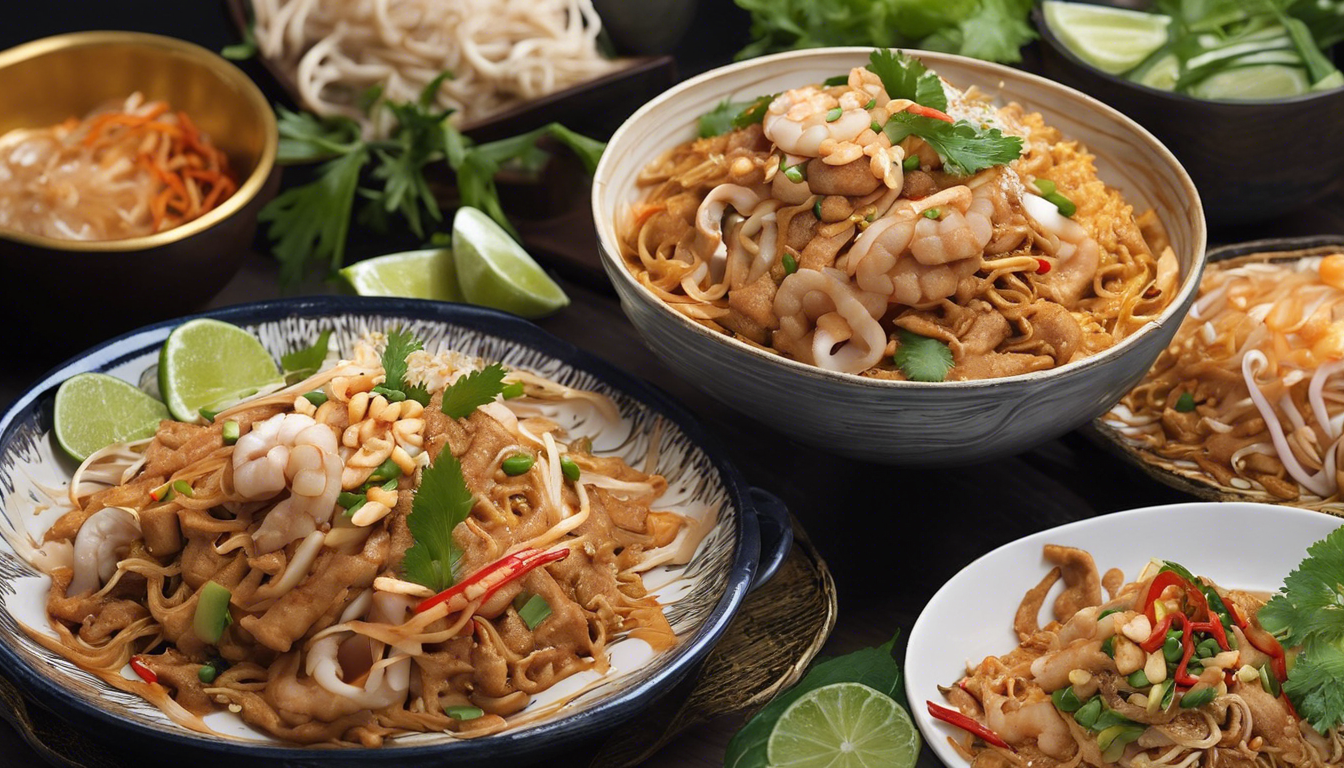
History and origins
Pad Thai, a beloved dish that has captured the hearts and palates of food enthusiasts worldwide, has a rich history that dates back to the mid-20th century. This iconic Thai street food is a harmonious blend of flavors and textures, embodying the essence of Thai cuisine. The origins of Pad Thai can be traced to the period of World War II, when Thailand, then known as Siam, was facing a severe rice shortage due to the war and floods. To combat this, the Thai government, under the leadership of Prime Minister Plaek Phibunsongkhram, promoted the consumption of noodles as an alternative to rice.
Phibunsongkhram, who was keen on modernizing Thailand and fostering a sense of national identity, saw an opportunity to create a national dish that would not only address the rice shortage but also promote Thai culture. He encouraged street vendors to sell a new noodle dish that was both nutritious and affordable. This dish, which we now know as Pad Thai, was a clever adaptation of Chinese stir-fried noodles, infused with distinctly Thai ingredients and flavors.
The name “Pad Thai” itself reflects this blend of influences. “Pad” means “stir-fried” in Thai, while “Thai” signifies the national identity of the dish. Over time, Pad Thai evolved, incorporating local ingredients such as tamarind paste, fish sauce, dried shrimp, and palm sugar, which gave it its unique sweet, sour, and savory profile. The dish quickly gained popularity and became a staple of Thai street food culture, loved by locals and tourists alike.
Today, Pad Thai is not just a dish; it is a symbol of Thai culinary heritage. It represents the ingenuity and adaptability of Thai cuisine, showcasing how traditional flavors can be preserved and celebrated even in times of adversity. Whether enjoyed from a bustling street vendor in Bangkok or a high-end restaurant in New York, Pad Thai continues to be a testament to the rich history and vibrant culture of Thailand.
Key ingredients and preparation
Creating an authentic Pad Thai requires a careful selection of ingredients and a precise cooking method to achieve the perfect balance of flavors. Here is a detailed list of ingredients and step-by-step instructions to prepare this iconic dish.
Ingredients:
- 200g rice noodles
- 2 tablespoons vegetable oil
- 2 cloves garlic, minced
- 200g shrimp, peeled and deveined
- 2 eggs, lightly beaten
- 100g firm tofu, diced
- 1 cup bean sprouts
- 1/2 cup chives, chopped
- 1/4 cup roasted peanuts, crushed
- 1 lime, cut into wedges
- 2 tablespoons tamarind paste
- 3 tablespoons fish sauce
- 1 tablespoon palm sugar
- 1 tablespoon dried shrimp
- 1 teaspoon chili powder (optional)
Preparation:
- Soak the noodles: Place the rice noodles in a large bowl and cover with warm water. Let them soak for about 30 minutes or until they are soft but still slightly firm. Drain and set aside.
- Prepare the sauce: In a small bowl, mix the tamarind paste, fish sauce, and palm sugar until the sugar is dissolved. Adjust the balance of flavors to taste, ensuring a harmonious blend of sweet, sour, and salty.
- Cook the shrimp: Heat 1 tablespoon of vegetable oil in a large wok or skillet over medium-high heat. Add the shrimp and cook until they turn pink and are just cooked through, about 2-3 minutes. Remove the shrimp from the wok and set aside.
- Stir-fry the aromatics: In the same wok, add the remaining tablespoon of oil. Add the minced garlic and cook until fragrant, about 30 seconds.
- Add the tofu and eggs: Add the diced tofu to the wok and stir-fry until golden brown. Push the tofu to one side of the wok and pour the beaten eggs into the other side. Scramble the eggs until they are just set, then mix them with the tofu.
- Combine the ingredients: Add the soaked noodles to the wok, followed by the prepared sauce. Toss everything together to coat the noodles evenly with the sauce. Add the cooked shrimp, dried shrimp, and chili powder (if using), and continue to stir-fry for another 2-3 minutes.
- Finish with fresh ingredients: Add the bean sprouts and chopped chives to the wok. Toss everything together until the bean sprouts are slightly wilted but still crunchy.
- Serve: Transfer the Pad Thai to serving plates. Garnish with crushed peanuts and lime wedges. Serve immediately, allowing diners to squeeze fresh lime juice over their portions for an extra burst of flavor.
By following these steps and using high-quality ingredients, you can create a delicious and authentic Pad Thai that captures the essence of Thai cuisine. Enjoy the delightful combination of textures and flavors that make this dish a favorite around the world.
Variations and serving suggestions
Pad Thai is a versatile dish that lends itself to numerous variations, allowing you to tailor it to your taste preferences or dietary needs. Here are some popular variations and serving suggestions to inspire your next culinary adventure.
Variations:
- Chicken Pad Thai: Substitute the shrimp with thinly sliced chicken breast or thigh. Cook the chicken in the same manner as the shrimp, ensuring it is fully cooked before proceeding with the rest of the recipe.
- Vegetarian Pad Thai: Omit the shrimp and fish sauce, and use soy sauce or tamari as a substitute. Add more vegetables such as bell peppers, carrots, and snap peas for added texture and flavor.
- Vegan Pad Thai: Follow the vegetarian variation, but also replace the eggs with a vegan alternative such as scrambled tofu or chickpea flour batter. Ensure all other ingredients, like tamarind paste and soy sauce, are vegan-friendly.
- Seafood Pad Thai: Enhance the dish with a mix of seafood such as squid, scallops, and mussels. Cook each type of seafood separately to ensure they are perfectly done before combining them with the noodles.
- Spicy Pad Thai: Increase the amount of chili powder or add fresh Thai chilies to the dish. You can also serve it with a side of chili flakes or Sriracha sauce for those who prefer extra heat.
Serving Suggestions:
- Traditional Garnishes: Serve Pad Thai with traditional garnishes such as extra crushed peanuts, fresh lime wedges, and additional bean sprouts. These add texture and freshness to the dish.
- Herbs and Greens: Add a handful of fresh herbs like cilantro or Thai basil to the finished dish for a burst of aromatic flavor. You can also serve it with a side of mixed greens or a simple cucumber salad to balance the richness of the noodles.
- Accompaniments: Pair Pad Thai with other Thai dishes such as Tom Yum soup, green papaya salad (Som Tum), or spring rolls for a complete Thai meal experience.
- Plating: For an elegant presentation, serve Pad Thai on a large platter with garnishes arranged around the edges. This makes it easy for guests to customize their portions with their preferred toppings.
- Family Style: Pad Thai is perfect for sharing. Serve it family-style in a large bowl, allowing everyone to help themselves. This communal approach enhances the dining experience and brings people together.
Experimenting with these variations and serving suggestions can help you discover new and exciting ways to enjoy Pad Thai. Whether you stick to the classic recipe or put your own twist on it, this beloved dish is sure to delight your taste buds and those of your guests.
